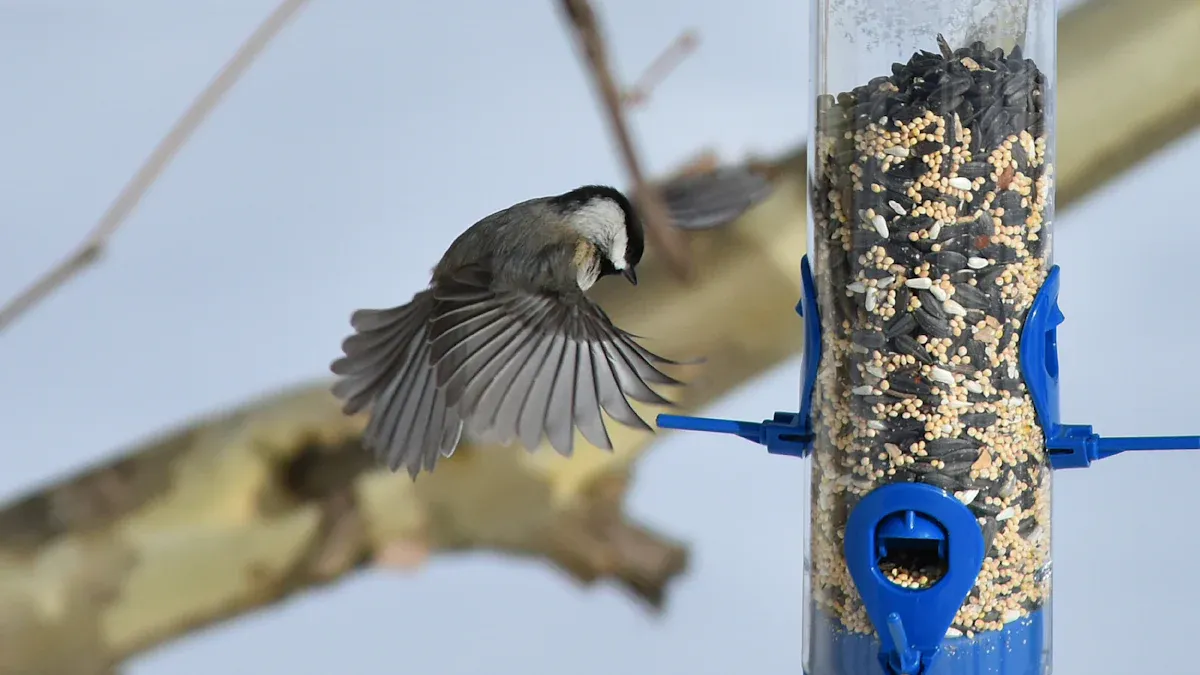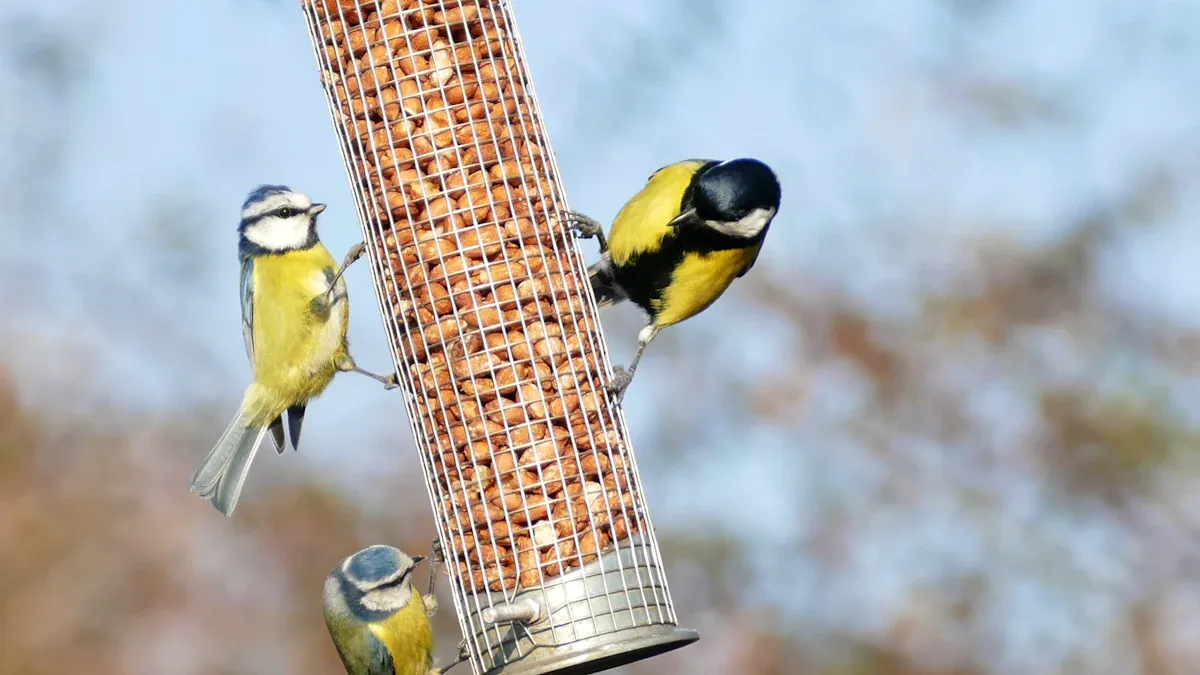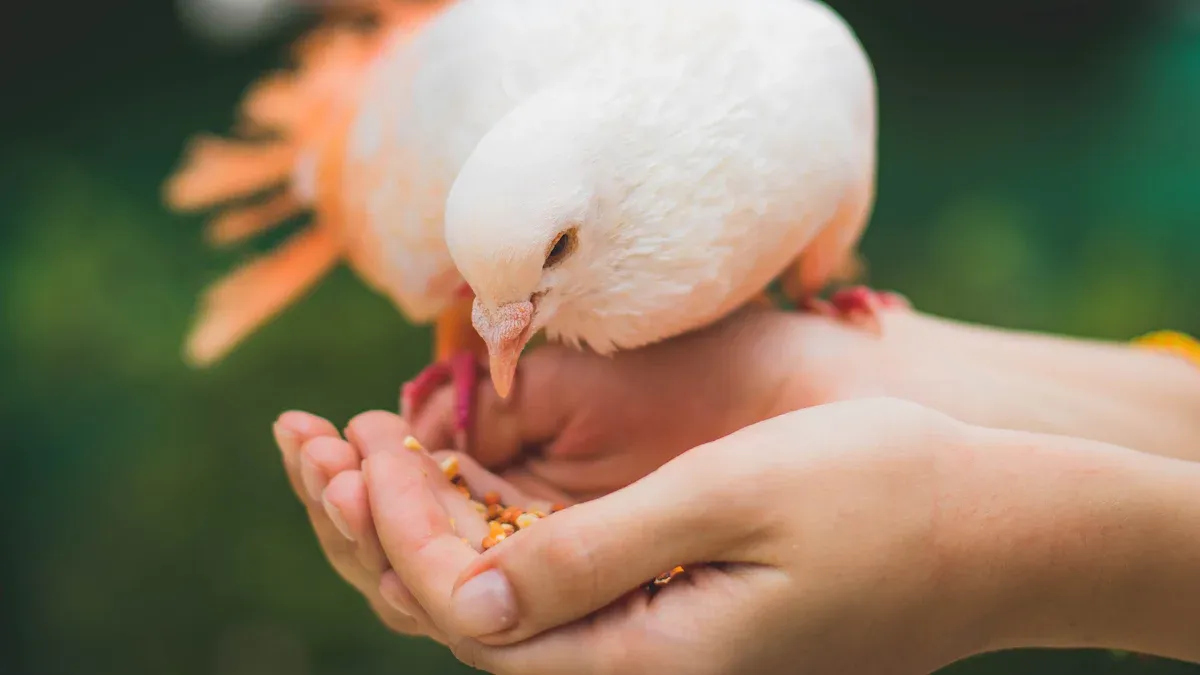
If you’re looking for a way to give birds a nutritious boost, Dried Mealworms for Birds are a fantastic choice. They’re packed with protein—over 50%—which helps birds build muscles, grow feathers, and stay healthy. Plus, they’re loaded with essential nutrients like iron and potassium. I love how convenient Dried Mealworms for Birds are to store and use. They don’t spoil quickly, and you can easily toss them into feeders or trays. Best of all, they attract a variety of birds, from bluebirds and robins to woodpeckers and wrens. It’s amazing to see so many species flock to your yard!
Key Takeaways
- Dried mealworms are a protein-rich snack for birds, helping them build muscles and stay healthy. Offer them regularly to attract a variety of species to your yard.
- Storing dried mealworms is easy. Keep them in airtight containers in a cool, dry place to maintain freshness and prevent spoilage.
- Mix dried mealworms with other bird foods to create a balanced diet. This encourages more birds to visit and enjoy your feeders.
Live vs. Dried Mealworms: Why Choose Dried?
Nutritional Benefits of Dried Mealworms
I’ve always been amazed at how much nutrition is packed into dried mealworms. They’re a powerhouse of protein—about 53%—which is essential for birds to build muscles, grow feathers, and stay active. This makes them especially helpful during breeding, moulting, or when young birds are growing. Plus, they’re loaded with vitamins, minerals like iron and potassium, and essential amino acids. These nutrients give birds the energy they need to thrive. Unlike live mealworms, dried ones offer a concentrated source of nutrition without the hassle of keeping them alive. It’s like giving birds a superfood snack!
Convenience and Long Shelf Life
One of the reasons I prefer dried mealworms is how easy they are to store and use. They don’t need refrigeration or special care, unlike live mealworms that require constant attention. I can keep a bag of dried mealworms in my pantry for months without worrying about spoilage. This long shelf life makes them a cost-effective option for bird feeding. Whether I’m filling a feeder or sprinkling some on the ground, they’re always ready to go. It’s such a relief not having to deal with wriggly, high-maintenance live mealworms.
Ease of Handling and Storage
Let’s be honest—handling live mealworms isn’t for everyone. They’re squirmy, messy, and can be a bit off-putting. Dried mealworms, on the other hand, are clean, lightweight, and easy to handle. I can scoop them out without any fuss, and they don’t leave behind any unpleasant residue. Storing them is just as simple. I use an airtight container to keep them fresh, and that’s it! No need for special equipment or extra effort. It’s a hassle-free way to enjoy feeding birds while keeping things tidy.
Bird Species That Enjoy Dried Mealworms for Birds

Common Backyard Birds
I’ve noticed that dried mealworms are a magnet for many common backyard birds. It’s always exciting to see which species show up at my feeders. Here’s a quick list of the ones I see most often:
- Bluebirds
- Chickadees
- Thrushes
- Titmice
- Wrens
- Nuthatches
- Kinglets
These birds seem to love the protein-packed snack. It’s like a treat they can’t resist! I’ve found that offering dried mealworms regularly keeps them coming back, making my yard a lively and colorful place.
Seasonal Visitors and Migratory Birds
Dried mealworms are also a lifesaver for seasonal and migratory birds. During their long journeys, these birds need extra energy to keep going. The high protein content in dried mealworms helps them build muscle and maintain their feathers, which are crucial for flying. I’ve noticed more birds stopping by during migration seasons, especially in the winter when natural food is scarce. It’s rewarding to know I’m helping them refuel and stay strong. Plus, it makes bird-watching even more enjoyable with such a variety of species visiting.
Benefits for Nesting and Breeding Birds
When birds are nesting or raising their young, they need all the energy they can get. Dried mealworms are perfect for this. They’re packed with protein and fat, giving birds the nutrients they need to feed their chicks and stay healthy themselves. I’ve seen parent birds grab mealworms and fly off to their nests—it’s such a heartwarming sight! Offering dried mealworms during the breeding season is one of the easiest ways to support local bird populations.
Storing Dried Mealworms Safely
Best Storage Containers
Choosing the right container for storing dried mealworms makes a big difference in keeping them fresh. I’ve found that containers with smooth walls work best because they prevent any mealworms from escaping. Shallow containers with wide mouths are also a great option since they allow better heat dissipation. Personally, I prefer using glass or sturdy plastic containers. They’re durable, and unlike cardboard or wood, they won’t get chewed through. Transparent containers are my go-to because I can easily check the mealworms without opening the lid. It’s a simple way to keep things organized and hassle-free.
Ideal Storage Conditions
Keeping dried mealworms fresh is all about storing them in the right conditions. I always make sure to store them in a cool, dry place. Airtight containers are a must to prevent moisture from sneaking in. I avoid direct sunlight by tucking them away in a dark cupboard or pantry. The ideal temperature range is between 60°F and 75°F, which helps maintain their quality. Before feeding, I like to inspect them for any off smells, discoloration, or mold. It’s a quick step that ensures the birds get only the best.
Preventing Spoilage or Contamination
Preventing spoilage and contamination takes a little effort, but it’s worth it. Here’s what I do:
- Store mealworms in a cool, dry spot to keep mold and pests away.
- Check the container regularly for signs of contamination like mites or waste.
- Clean the container every two weeks to avoid bacterial growth.
- Replace the substrate periodically to keep things fresh.
- Inspect the mealworms for any signs of spoilage before serving.
These steps help me keep the mealworms safe and ready for the birds to enjoy. 🐦
Serving Dried Mealworms to Birds

Types of Bird Feeders for Mealworms
Choosing the right bird feeder makes a big difference when serving dried mealworms. I’ve found that feeders with tall sides work best because they keep the mealworms from spilling out. A roof or rain guard is also essential to protect the mealworms from getting wet during rainy days. Drainage holes are another must-have feature. They prevent water from pooling, which keeps the mealworms fresh and safe for birds to eat. If you’re worried about squirrels or other animals tampering with the feeder, look for one with built-in deterrents. These features make feeding birds easier and more enjoyable for everyone involved.
Mixing Mealworms with Other Bird Foods
Sometimes, birds need a little encouragement to try something new. I like to mix dried mealworms with other bird foods, like seeds or suet, to make the mealworms more appealing. This combination not only attracts a wider variety of birds but also provides them with a balanced diet. For birds unfamiliar with mealworms, soaking them in lukewarm water can help. Moistening the mealworms makes them softer and more similar to live ones, which birds often find irresistible. Once one bird starts eating, others usually follow. It’s a simple trick that works wonders!
Offering Mealworms on the Ground or in Trays
Serving dried mealworms on the ground or in trays is another great option. Here’s a quick look at the benefits:
| Advantage | Description |
|---|---|
| Nutritional Value | Packed with protein, they’re perfect for birds, especially in colder months. |
| Attracting Diverse Species | You’ll see a variety of birds, even some rare ones, visiting your yard. |
| Eco-friendly Options | Mealworms are sustainably produced, making them an environmentally friendly choice. |
| Easy to Use | Trays are simple to set up and maintain, letting you observe birds up close. |
I’ve noticed that ground feeding works well for species like robins and thrushes, while trays are ideal for keeping things tidy. Either way, it’s a win-win for you and the birds!
Appropriate Serving Sizes for Dried Mealworms
Daily Feeding Recommendations
When it comes to feeding dried mealworms, moderation is key. I usually start with a small handful—about a tablespoon per feeder. This amount works well for most backyard birds. Dried mealworms are packed with protein, which is vital for muscle development, feather production, and overall vitality. Birds especially benefit from this during breeding, moulting, or when they’re raising chicks. While mealworms are a fantastic treat, they shouldn’t replace a bird’s regular diet. I like to think of them as a protein-packed snack rather than the main course.
If you’re new to feeding mealworms, try offering them in small amounts first. This helps you gauge how much the birds in your yard will eat. Over time, you’ll get a sense of the right portion size for your feathered visitors.
Adjusting Portions Based on Bird Activity
Bird activity can vary depending on the season, weather, and even the time of day. I’ve noticed that during migration or colder months, birds tend to eat more. In these cases, I increase the portion slightly to help them refuel. On quieter days, I scale back to avoid waste. It’s all about observing your yard and adjusting accordingly.
One trick I’ve learned is to split the mealworms into multiple feeders or trays. This prevents overcrowding and ensures that all birds get a chance to eat. If you see leftover mealworms at the end of the day, it’s a sign to reduce the portion next time.
Avoiding Overfeeding and Waste
Overfeeding isn’t a huge risk with dried mealworms, but it’s still a good idea to avoid waste. Birds love variety, so I mix mealworms with seeds or suet to create a balanced diet. Using a feeder designed specifically for mealworms helps prevent spillage. I also rehydrate the worms occasionally to make them softer and easier to eat, especially for younger or smaller birds.
Here are a few tips I follow to minimize waste:
- Use high-quality, organic dried mealworms to ensure freshness.
- Regularly clean the feeder to prevent mold or spoilage.
- Store mealworms in a cool, dry place to keep them safe and tasty.
By keeping portions reasonable and feeders clean, I’ve found that feeding birds becomes a rewarding and eco-friendly experience. Plus, it’s a joy to see them thrive on such a nutritious treat! 🐦
Cost-Effective Ways to Use Dried Mealworms for Birds
Buying in Bulk
I’ve found that buying dried mealworms in bulk is one of the easiest ways to save money. Larger bags often cost less per ounce compared to smaller packages. Plus, they last a long time if stored properly. I always keep mine in a sealed bag or airtight container to maintain freshness. This way, I don’t have to worry about spoilage or waste. Offering mealworms in small quantities year-round also helps stretch my supply. Birds love them, and I love the savings!
If you’re just starting out, try moistening the mealworms slightly before serving. It makes them more appealing to birds, especially those unfamiliar with dried mealworms. Once they get a taste, they’ll keep coming back for more.
DIY Bird Feeder Ideas
Making your own bird feeder is not only fun but also budget-friendly. I’ve tried a few DIY ideas, and they work great for serving dried mealworms. Here are some of my favorites:
- Wood Feeder: With some wood, clear plexiglass, and basic tools, you can create a sturdy feeder with multiple access holes.
- Recycled Cans Feeder: Clean a few cans, drill holes, and twist them together with wire. Add some decorations for a personal touch!
- Plastic Bottle Feeder: Cut holes in a large plastic jar and use the twist-off cap for easy refilling.
These feeders are simple to make and perfect for keeping mealworms secure and fresh. Plus, they’re a great way to recycle materials you already have at home.
Combining Mealworms with Other Affordable Foods
To make feeding birds even more cost-effective, I like to mix dried mealworms with other foods. Seeds, suet, or even small pieces of fruit pair well with mealworms. This combination not only stretches my supply but also attracts a wider variety of birds. It’s like creating a buffet for them!
Sometimes, I soak the mealworms in lukewarm water before mixing. This softens them and makes them more appealing, especially for younger or smaller birds. Using feeders with tall sides and drainage holes also helps keep the mix fresh and prevents waste. It’s a simple way to make the most of your bird-feeding budget while keeping your feathered friends happy. 🐦
Feeding birds dried mealworms for birds is a simple yet impactful way to support their health and attract diverse species. Firstly, dried mealworms are a rich source of protein, vital for muscle development, feather production, and overall vitality in birds. They’re easy to store, clean to handle, and versatile to serve.
Birders often share how mealworms bring more activity and variety to their yards, fostering a deeper connection with nature.
| Evidence Type | Description |
|---|---|
| Nutritional Benefits | Dried mealworms provide essential nutrients that can enhance bird health and reproductive success. |
| Practical Experience | Birders report increased bird activity and diversity when mealworms are included in feeding. |
| Anecdotal Testimonials | Experienced birders share positive experiences of attracting more birds with mealworms. |
Try adding them to your bird-feeding routine. You’ll enjoy watching your feathered visitors thrive while creating a lively, colorful yard. 🐦
FAQ
How often should I feed dried mealworms to birds?
I recommend offering dried mealworms a few times a week. They’re a nutritious treat but shouldn’t replace a bird’s regular diet of seeds or fruits.
Can I feed dried mealworms to baby birds?
Yes, but soak them in water first. This softens the mealworms, making them easier for baby birds to eat and digest. It’s a great protein boost for growth.
Why aren’t birds eating the dried mealworms?
Some birds need time to adjust. Try mixing mealworms with seeds or soaking them in water. This makes them more appealing and similar to live mealworms.


